目录
移除链表元素(力扣)

思路:
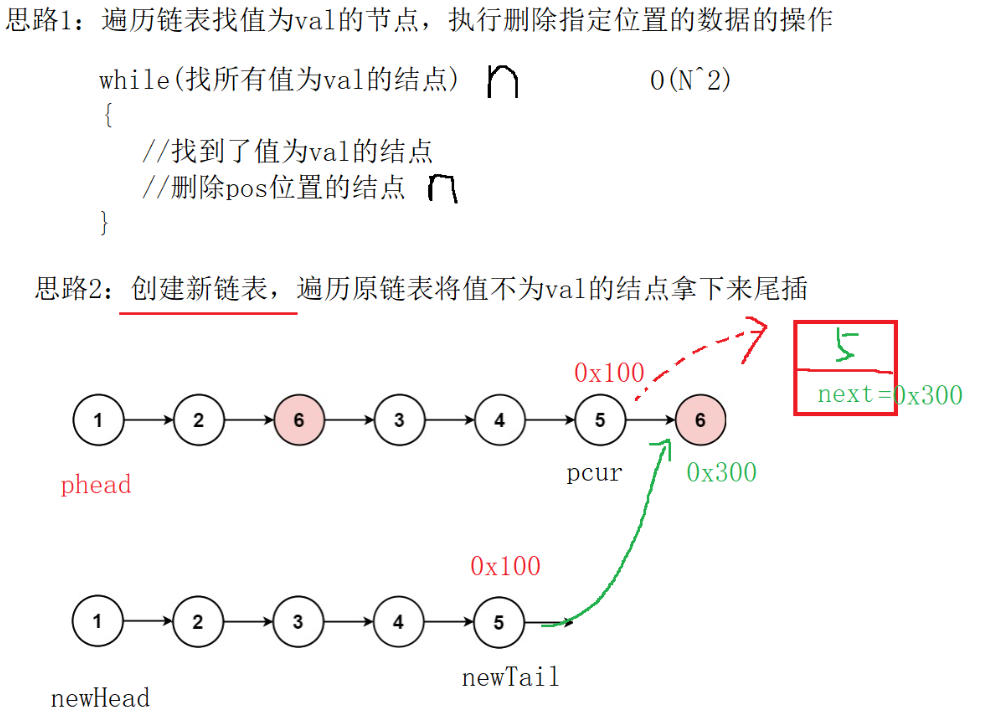
代码形成:
/**
* Definition for singly-linked list.
* struct ListNode {
* int val;
* struct ListNode *next;
* };
*/
typedef struct ListNode ListNode;
struct ListNode* removeElements(struct ListNode* head, int val) {
//创建空链表
ListNode*newHead,*newtail;
newHead=newtail=NULL;
ListNode*pcur=head;
while(pcur)
{
//把不为val的值插入新链表中
if(pcur->val!=val)
{
//尾插
//链表为空
if(newHead==NULL)
{
newHead=newtail=pcur;
}else
{
newtail->next=pcur;
newtail=newtail->next;
}
}
pcur=pcur->next;
}
if(newtail)
newtail->next=NULL;
return newHead;
}注意:
newHead和newtail用于维护新链表(存放所有不等于val的节点),初始为空。pcur用于遍历原链表,逐个检查节点的值- 关键:原链表中被插入新链表的节点,其
next指针可能指向原链表中的其他节点(甚至是需要删除的节点)。因此,新链表构建完成后,必须将尾节点的next置空,否则新链表可能包含不需要的节点或形成环。
反转链表(力扣)
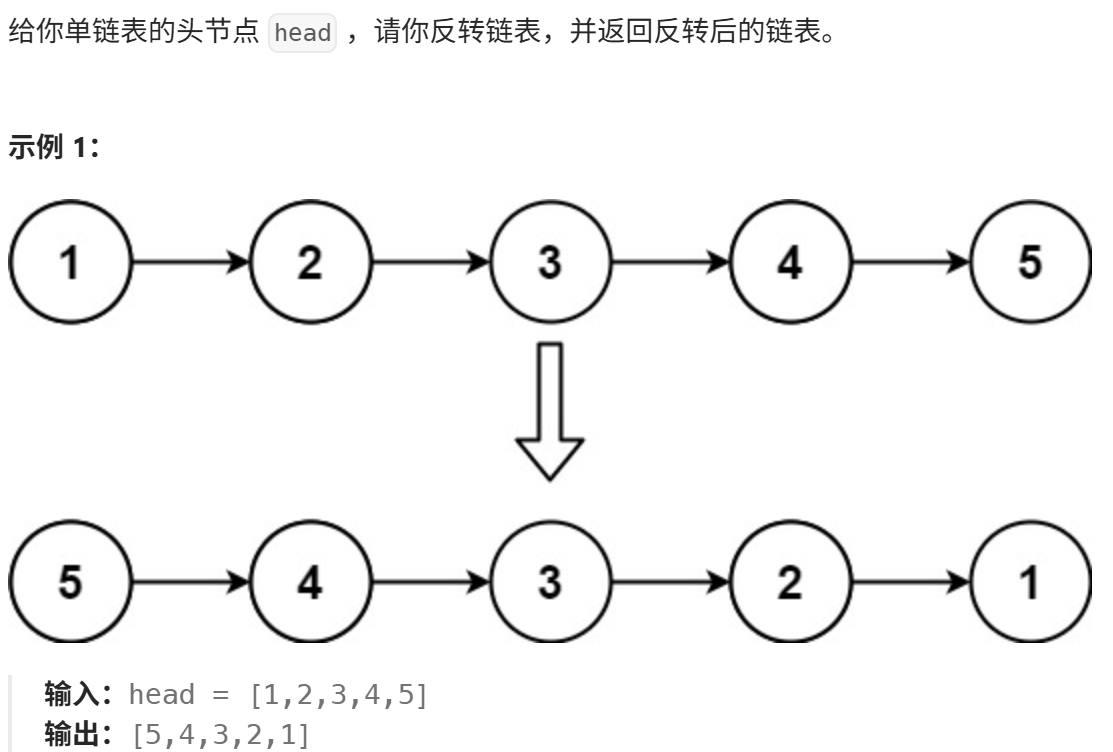
思路:

通过三个指针(n1、n2、n3)逐步遍历链表,逐个反转节点的指向关系。具体来说:
n2 指向当前需要处理的节点
n1 指向 n2 的前一个节点(反转后 n2 要指向的节点)
n3 保存 n2 的下一个节点(防止反转后丢失后续节点)
通过循环让这三个指针依次后移,直到 n2 为空(遍历完所有节点),此时 n1 就是反转后链表的头节点。
代码:
/**
* Definition for singly-linked list.
* struct ListNode {
* int val;
* struct ListNode *next;
* };
*/
struct ListNode* reverseList(struct ListNode* head) {
//链表为空
typedef struct ListNode ListNode;
if(head==NULL)
{
return head;
}//如果原链表为空(头节点为 NULL),直接返回 NULL,避免后续操作出错。
//创建三个指针
ListNode*n1,*n2,*n3;
//初始化
n1=NULL,n2=head,n3=n2->next;
while(n2)
{
n2->next=n1;
n1=n2;
n2=n3;
if(n3)
n3=n3->next;
}
return n1;
}注意:
- 代码正确处理了空链表的边界情况
- 当
n3为NULL时(即n2是最后一个节点),不再执行n3 = n3->next,避免空指针访问 - 整个过程只需要三个额外指针,空间效率高
- 反转后原链表的头节点会变成尾节点(
next为NULL),符合链表规范
迭代法
/**
* Definition for singly-linked list.
* struct ListNode {
* int val;
* struct ListNode *next;
* };
*/
typedef struct ListNode ListNode;
struct ListNode* reverseList(struct ListNode* head) {
// 终止条件:空链表或只有一个节点,直接返回
if (head == NULL || head->next == NULL) {
return head;
}
// 递归反转后续节点,得到反转后的头节点
ListNode* newHead = reverseList(head->next);
// 反转当前节点与下一个节点的指向
head->next->next = head; // 让下一个节点指向当前节点
head->next = NULL; // 当前节点成为尾节点,指向NULL
return newHead; // 始终返回反转后的头节点(原链表的最后一个节点)
}适用于理解递归思想,但不适合长链表,可能会导致栈溢出
链表的中间结点(力扣)(快慢指针法)
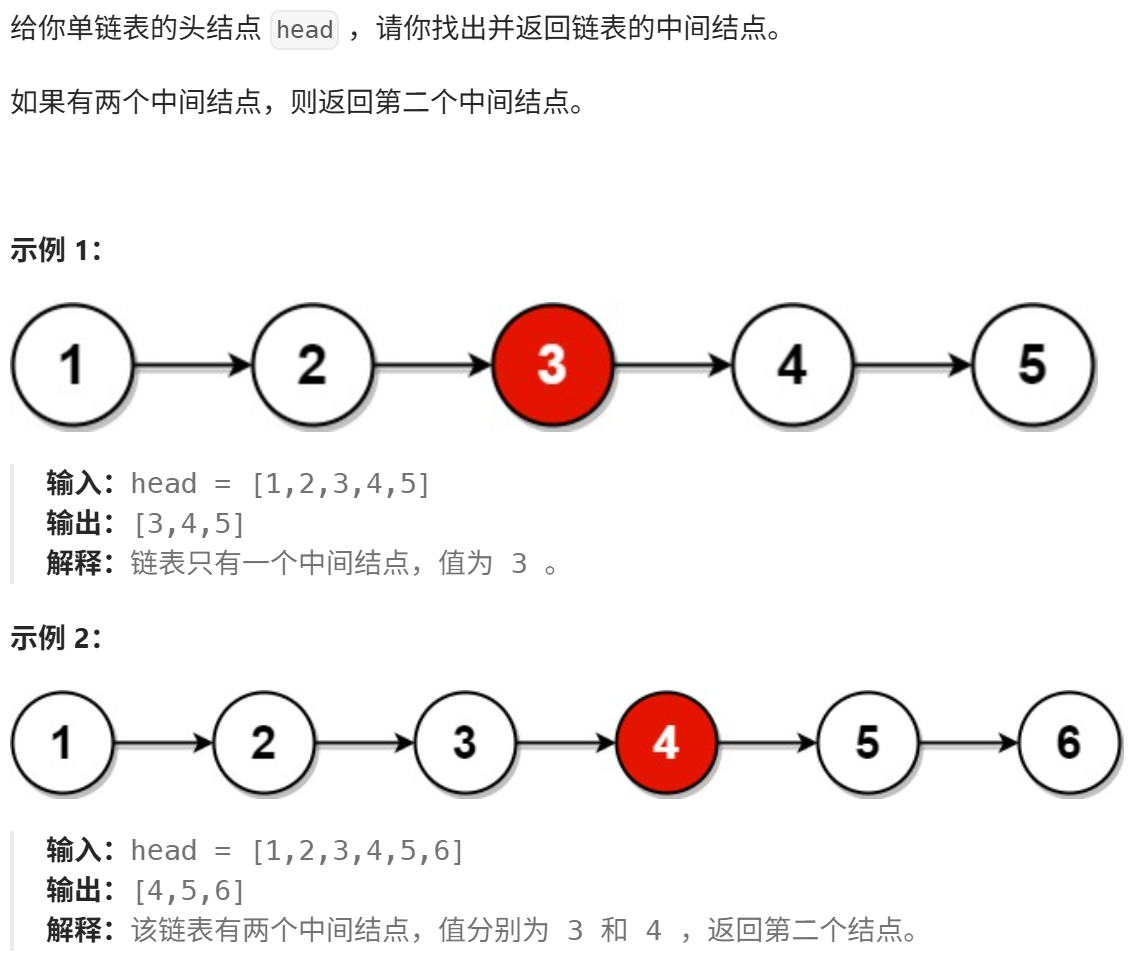
思路:
快慢指针实现代码
/**
* Definition for singly-linked list.
* struct ListNode {
* int val;
* struct ListNode *next;
* };
*/
typedef struct ListNode ListNode;
struct ListNode* middleNode(struct ListNode* head) {
ListNode*l1,*l2;
l1=l2=head;
while(l1&&l1->next)
{
l1=l1->next->next;
l2=l2->next;
}
return l2;
}循环逻辑:
- 当
l1能继续移动(即l1不为空且l1->next不为空)时,继续循环。 - 每次循环中,
l1前进 2 步,l2前进 1 步,保持l1的速度是l2的 2 倍。 - 当循环结束时,
l1已到达或超过链表末尾,此时l2刚好在中间位置。
注意事项
边界情况处理:
- 若链表为空(
head=NULL),快慢指针均为NULL,直接返回NULL,符合预期。 - 若链表只有一个节点,循环不执行,直接返回该节点,正确。
- 若链表为空(
偶数长度的中间节点定义:
- 代码返回的是偶数长度链表的第二个中间节点(如
1->2->3->4返回3)。 - 若需要返回第一个中间节点(如
1->2->3->4返回2),只需调整循环条件为while(l1->next && l1->next->next)即可。
- 代码返回的是偶数长度链表的第二个中间节点(如
合并两个有序链表
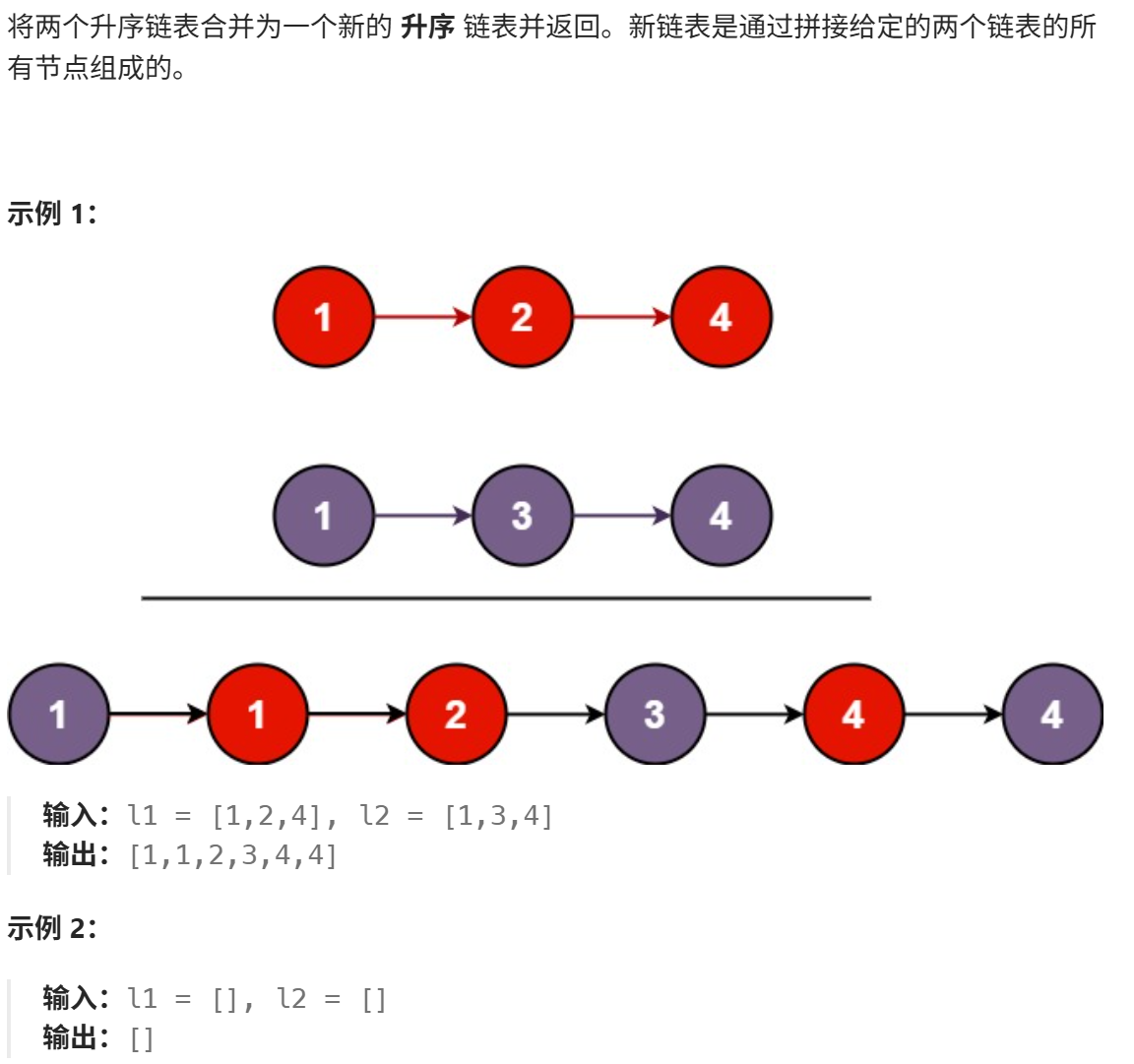
思路:

代码实现:
/**
* Definition for singly-linked list.
* struct ListNode {
* int val;
* struct ListNode *next;
* };
*/
typedef struct ListNode ListNode;
struct ListNode* mergeTwoLists(struct ListNode* list1, struct ListNode* list2) {
if (list1 == NULL)
return list2;
if (list2 == NULL)
return list1;
ListNode *newhead, *newtail;
newhead=newtail = (ListNode*)malloc(sizeof(ListNode));//申请一个节点空间,非空结点
while (list1 && list2) {
if (list1->val < list2->val) {
// 将1插入newhead后面
newtail->next = list1;
newtail = newtail->next;
list1 = list1->next;
}
else
{
newtail->next = list2;
newtail = newtail->next;
list2 = list2->next;
}
}
//总有一个先结束
if(list1)
{
newtail->next=list1;
}
if(list2)
{
newtail->next=list2;
}
ListNode*rethead=newhead->next;
free(newhead);
newhead=NULL;
return rethead;
}- 哨兵节点(也称哑节点)是一个临时创建的空节点,用于简化链表操作(避免处理头节点为空的特殊情况)。
newhead指向哨兵节点,newtail始终指向新链表的尾节点(初始时与newhead相同)。
核心循环
while (list1 && list2) { // 当两个链表都不为空时
if (list1->val < list2->val) {
newtail->next = list1; // 将list1的当前节点接入新链表
newtail = newtail->next; // 尾指针后移
list1 = list1->next; // list1指针后移
} else {
newtail->next = list2; // 将list2的当前节点接入新链表
newtail = newtail->next;
list2 = list2->next;
}
}
- 循环结束条件:其中一个链表的节点被全部接入(
list1或list2为空)。 - 循环结束后,剩余未接入的节点一定是有序的(原链表本身有序),直接将其整体接入新链表尾部即可。
申请空间,要释放
ListNode* rethead = newhead->next; // 新链表的真实头节点是哨兵节点的下一个
free(newhead); // 释放哨兵节点(避免内存泄漏)
newhead = NULL;
return rethead;优势:
- 时间复杂度:O (n + m),其中 n 和 m 分别是两个链表的长度(每个节点仅遍历一次)。
- 空间复杂度:O (1),仅使用常数级额外空间(哨兵节点在最后释放,不算有效空间)。
- 稳定性:保持原链表中相同值节点的相对顺序(例如:若两节点值相等,优先接入
list2的节点,符合代码逻辑)。
改进:
newtail->next = list1 ? list1 : list2;
有一组遍历完后,使用这组更简便
链表的回文结构
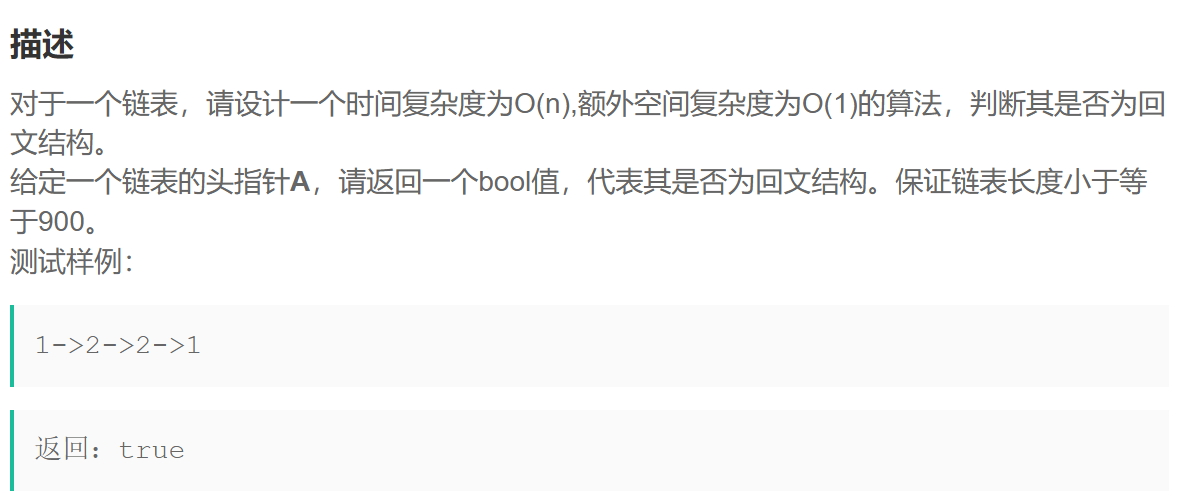
思路1:

代码实现:
/*
struct ListNode {
int val;
struct ListNode *next;
ListNode(int x) : val(x), next(NULL) {}
};*/
class PalindromeList {
public:
bool chkPalindrome(ListNode* A) {
//创建数组-900
int arr[900];
//遍历链表将值保存在数组中
ListNode* pcur=A;
int i = 0;
while (pcur) {
arr[i++] = pcur->val;
pcur = pcur->next;
}
//判断数组是否为回文结构
int left = 0;
int right = i - 1;
while (left < right) {
if (arr[left] != arr[right]) {
return false;
}
left++;
right--;
}
return true;
}
};潜在改进点
数组大小固定的问题
- 目前数组大小固定为 900,如果链表长度超过 900,会导致数组越界
- 可以考虑使用动态分配内存(如new 操作符),根据实际链表长度创建数组
空间复杂度优化
- 目前空间复杂度为 O (n),可以优化到 O (1):
- 找到链表中点
- 反转后半部分链表
- 比较前半部分和反转后的后半部分
- 目前空间复杂度为 O (n),可以优化到 O (1):
思路2:
![]()
代码
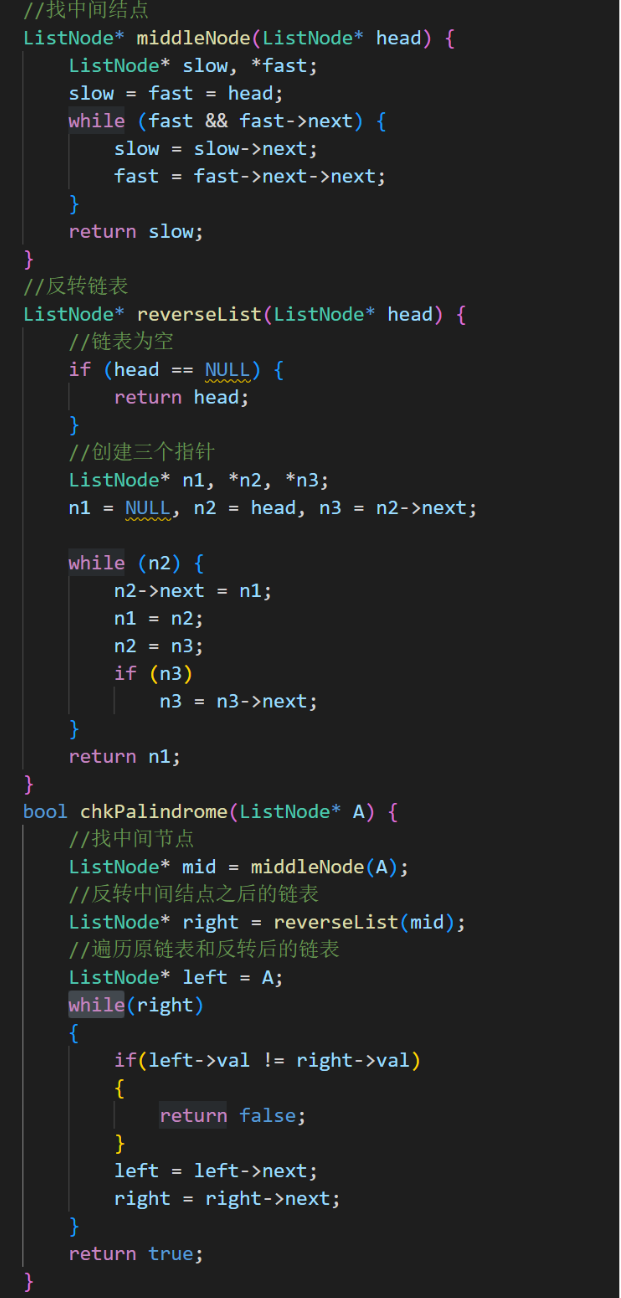
该方法相对复杂,但空间复杂度为o(1)
相交链表

思路:
![]()
代码:
/**
* Definition for singly-linked list.
* struct ListNode {
* int val;
* struct ListNode *next;
* };
*/
typedef struct ListNode ListNode;
// 计算链表长度的函数
int getLength(ListNode* head) {
int count = 0;
ListNode* current = head;
while (current) {
count++;
current = current->next;
}
return count;
}
struct ListNode *getIntersectionNode(struct ListNode *headA, struct ListNode *headB) {
// 计算两个链表的长度
int lenA = getLength(headA);
int lenB = getLength(headB);
// 确定较长的链表和较短的链表
ListNode* longList = lenA > lenB ? headA : headB;
ListNode* shortList = lenA > lenB ? headB : headA;
// 让较长的链表先走长度差的步数
int diff = abs(lenA - lenB);
for (int i = 0; i < diff; i++) {
longList = longList->next;
}
// 同时移动两个链表的指针,寻找交点
while (longList && shortList) {
// 找到交点
if (longList == shortList) {
return longList;
}
longList = longList->next;
shortList = shortList->next;
}
// 没有交点
return NULL;
}- 时间复杂度:O (n + m),其中 n 和 m 分别是两个链表的长度
- 空间复杂度:O (1),只使用了常数个额外空间
环形链表
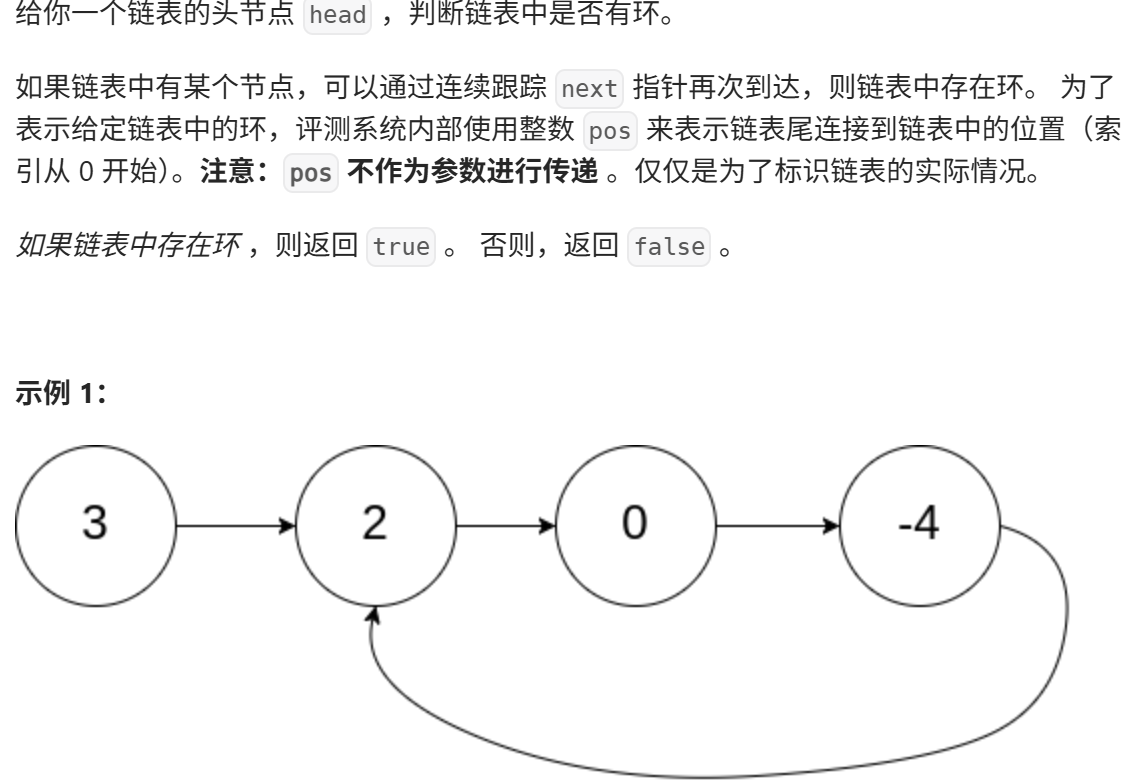
思路:
代码:
/**
* Definition for singly-linked list.
* struct ListNode {
* int val;
* struct ListNode *next;
* };
*/
//快慢指针
typedef struct ListNode ListNode;
bool hasCycle(struct ListNode *head) {
ListNode*fast=head;
ListNode*slow=head;
while(fast&&fast->next)
{
fast=fast->next->next;
slow=slow->next;
if(slow==fast)
{
return true;
}
}
return false;
}- 时间复杂度:O (n),其中 n 是链表的长度。在有环的情况下,快指针最多绕环一周就能追上慢指针
- 空间复杂度:O (1),只使用了常数个额外空间,这是该算法相比哈希表方法的优势
环形链表2
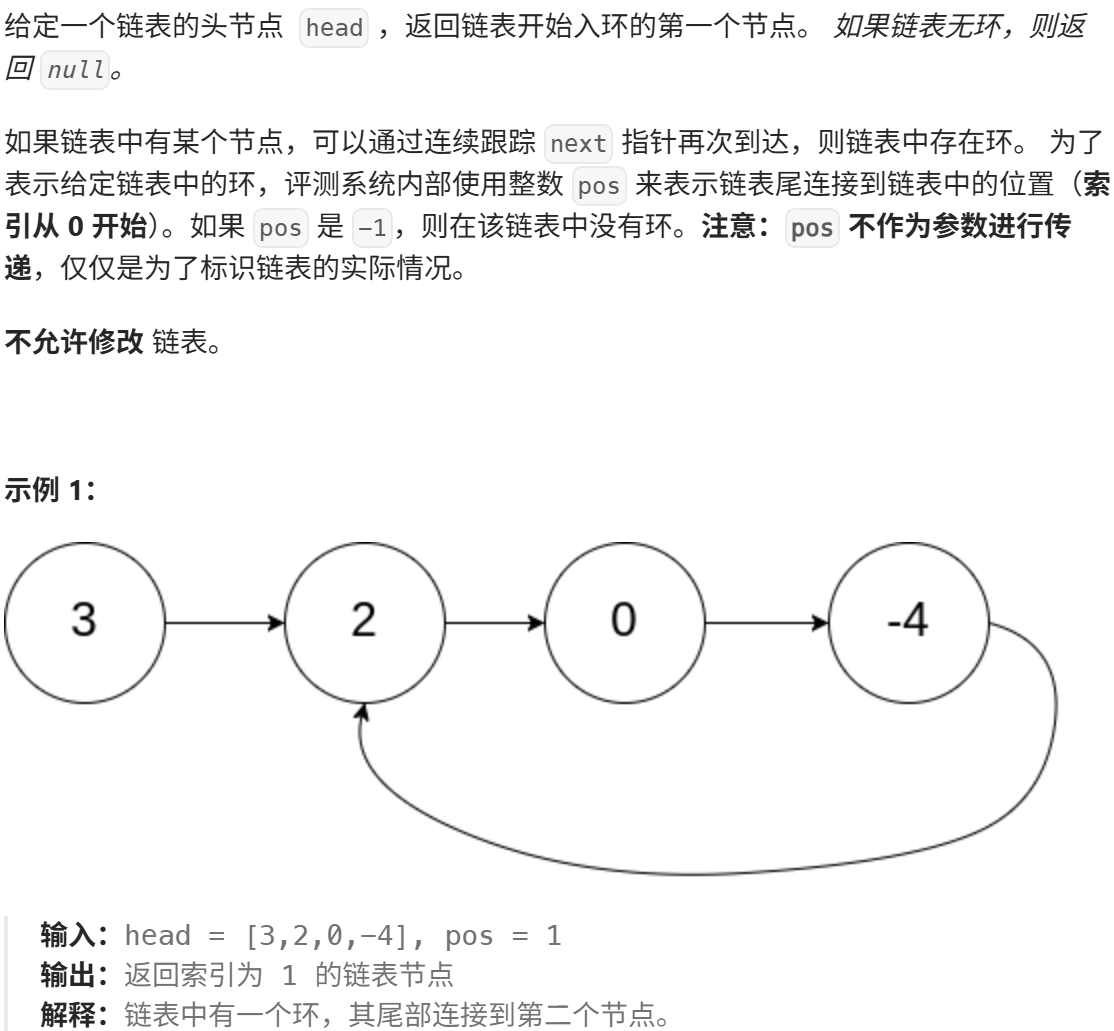
思路:
代码:
/**
* Definition for singly-linked list.
* struct ListNode {
* int val;
* struct ListNode *next;
* };
*/
typedef struct ListNode ListNode;
struct ListNode *detectCycle(struct ListNode *head) {
//快慢指针
ListNode*slow=head;
ListNode*fast=head;
while(fast&&fast->next)
{
slow=slow->next;
fast=fast->next->next;
if(fast==slow)
{
ListNode*pcur=head;
while(pcur!=slow)
{
//找进入环点
pcur=pcur->next;
slow=slow->next;
}
return pcur;
}
}
return NULL;
}- 若链表存在环,快慢指针必定会在环内相遇(这是判断环存在的基础)
- 当快慢指针相遇后,将一个指针移到链表头部,两个指针以相同速度前进,它们再次相遇的位置就是环的入口节点
- 时间复杂度:O (n),其中 n 是链表的长度
- 空间复杂度:O (1),只使用了常数个额外空间